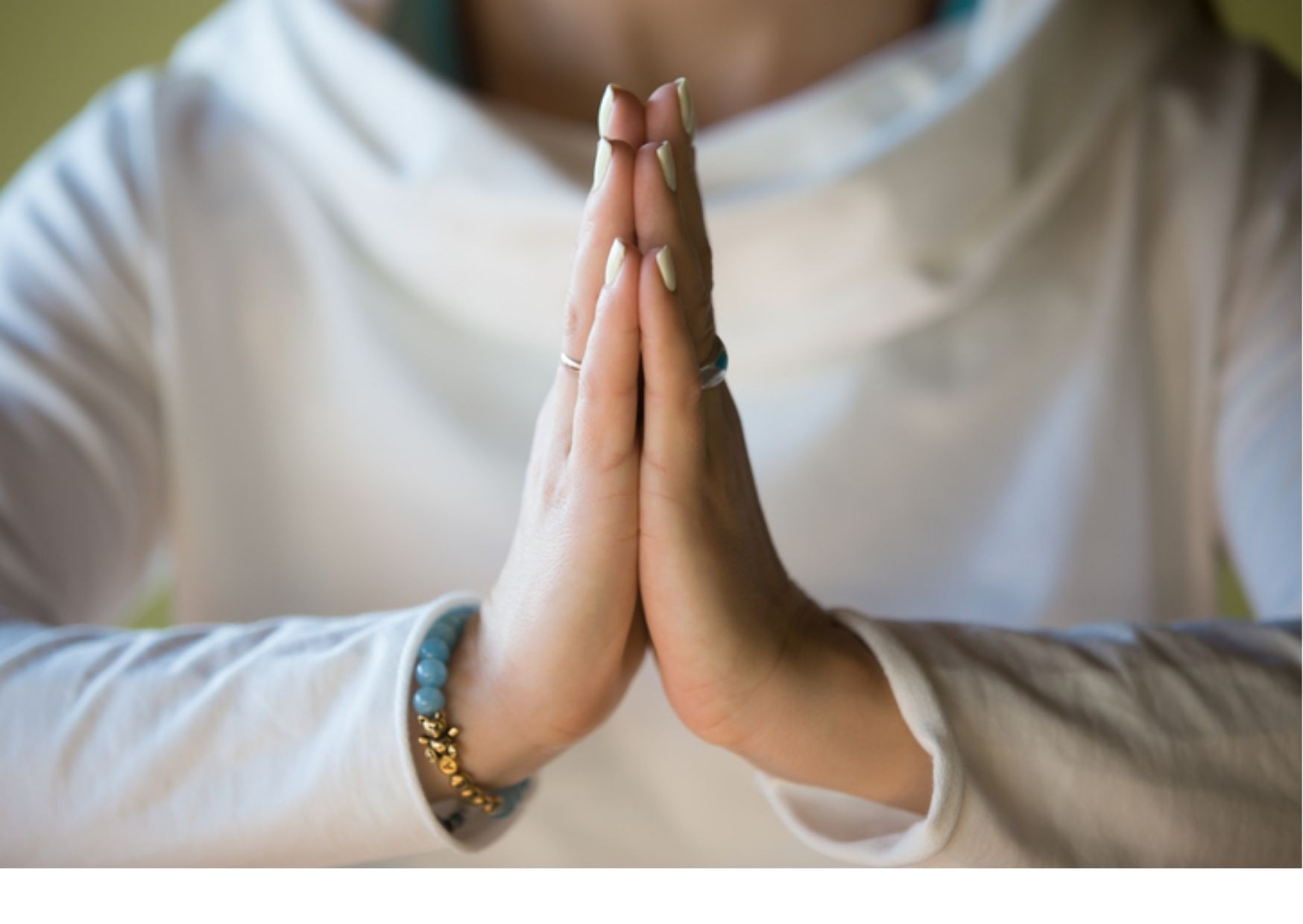
The Meaning And Use Of Namaste
Table of Contents
Namaste is a simple gesture (or mudra) made by bringing both palms of the hands together in front of the heart and gently bowing the head. In the simplest terms, it is regarded as a heartfelt greeting that is reciprocated.
Namaste is pronounced "Namastay" and is derived from two Sanskrit terms, Nama and te. Te denotes you, and Nama denotes bending, inclining, or bowing. Combining these two terms conveys an attitude of complete submission to another.
The word nama is composed of two parts, na and ma. Na denotes negation, and ma denotes mine. Then the meaning would be 'not mine.' The significance is that the individual soul depends entirely on the supreme soul, which is identified as residing in the individual addressed by the Namaste. Indeed, the soul can claim nothing as its own. Namaste is thus a necessary rejection of the 'I' and its associated egotistic phenomena. It is said that the term 'ma' in nama refers to spiritual death and that when negated (na-ma), it refers to immortality.
The Use Of Namaste
The entire action of Namaste occurs on three levels:
- Mental
- Physical
- Verbal
Mental submission is made in the spirit of complete self-surrender. This is comparable to the expression of devotion toward a chosen deity, also known as bhakti. The devotee who performs this submission with complete self-surrender is believed to partake in the merits or qualities of the person or deity to whom he is submitting. A transaction can only occur between equals, between individuals who share certain characteristics. Thus, by performing Namaste in front of an individual, we acknowledge his divine spark. Additionally, by facilitating our access to these divine qualities, Namaste awakens us to the divine characteristics that reside within our selves. In a nutshell, Namaste implies the following:
- The God within me extends a greeting to the God within you.
- The Spirit within me encounters the Spirit within you.
In other words, it acknowledges everyone's equality and honors the sacredness of everyone, regardless of age, status, or wealth. When translated into a physical gesture, Namaste is brimming with symbolism. To begin, a proper Namaste requires that the five fingers of the left hand be perfectly aligned with the fingers of the right hand. The significance of this seemingly insignificant act governs the entirety of our active lives. The five fingers on the left hand correspond to the five karma senses, while the five fingers on the right hand correspond to the five organs of knowledge. As a result, it implies that our karma or actions must be harmonious and guided by correct knowledge, prompting us to think and act appropriately.

Namaste acknowledges the inherent duality in this world. It suggests an effort on our part to bring these two forces together, ultimately resulting in a higher unity and non-dual state of Oneness. Several of these dual elements that the Namaste gesture brings together and unifies as one are as follows:
- Astral body (consciousness) and Etheric body (sensation)
- Mind and body
- Conscious and Unconscious
- Intellect and Instinct
- Reason and Emotion
- Thought and Feeling
- Word and Meaning
- God and Goddess
- Man and Woman
- Heaven and Earth
- Sun and Moon
- Theory and Practice
- Wisdom and Method
- Pleasure and Pain
Finally, the Namaste gesture is unique in that it is accompanied by the verbal utterance of the word "Namaste." This is analogous to chanting a mantra. The sacred sound 'Namaste' possesses a quasi-magical quality, corresponding to a shift in creative energy. This transformation is one of re-aligning oneself with the cosmos's vibration. At its most basic level, Namaste is a social exchange. When individuals meet, it is customary for them to greet one another. It is not only a sign of recognition but also an expression of joy at the prospect of seeing each other. This initial conviviality establishes a favorable foundation for developing a harmonious relationship.
As a greeting, Namaste is thus a kaleidoscope of movements and words expressing affirmative thoughts and sentiments. It is an approach mechanism in human society, brimming with social, emotional, and spiritual significance. Indeed, it is said that Namaste combines the hands like a knife, allowing people to cut through any perceived differences and immediately reach the shared ground shared by all peoples of all cultures. A comparison to the widely used 'handshake' is unavoidable in this context.
While shaking hands is an extremely intimate gesture, Namaste has some advantages. Primarily, Namaste is a great equalizer. You greet God with a Namaste (and not a handshake!). A king or president cannot shake hands with a large crowd. However, Namaste serves its purpose. It is the same gesture one would exchange with a king if they were alone with him. As a result, no contradiction occurs. In the absence of Namaste, those addressing a large audience will have to settle for a wave of the hands. This much less friendly greeting does not express the fundamental equality of all people but rather emphasizes their differences. On a parallel level, it has been hypothesized that both the Namaste and the handshake evolved out of a desire for both parties to demonstrate their innocence and lack of malice. The outstretched hand and entwined palms both establish the proponents as disarmed and demonstrate their intention to come in peace.
As much as yoga is an exercise for bringing all aspects of our being, physical and mental, into complete harmony with the rhythms of nature, the gesture of Namaste is a form of yoga in and of itself. Unsurprisingly, all yogic activities begin with this profoundly spiritual gesture.
The Buddhists elevated it to the status of a mudra, a gesture displayed by deities, and dubbed it the Anjali mudra. Anjali is derived from the root Anj, which means "to embellish, honor, celebrate, or anoint." According to Indologist Renov, "meditation is contingent upon the interaction of the hands (mudras), the mouth (mantras), and the mind (yoga)."
Namaste is a performance that entails all three of these activities. Thus, Namaste is fundamentally equivalent to meditation, the language of our spirit conversing with God and the ideal vehicle for bathing us in divine pleasure rivers.

Related
Chanting And Toning With Karuna Reiki
The Karuna Reiki experience taught me that toning or chanting during a Karuna Reiki session causes profound shifts in the healing energy's vibrational frequency. The Mahayana Buddhist tradition of the bodhisattva Avalokitesvhara, who creates the Sound that Illuminates the World, validates this notion.
The Ethics Of Distant Reiki Healing
The Second Degree procedures teach you how to transmit powerful healing to anybody, anywhere, at any time, including the past and future. Using the Distant (Connection) Symbol helps you to construct a bridge between you and the person (or animal) you wish to heal.
Guided Meditation To Help Heal The Shadow Self Can Change Your Life
The shadow self refers to the aspects of ourselves that have been repressed into the unconscious — the aspects of ourselves that we are insecure about, ashamed of, or frustrated with. The shadow self-concept is based on the idea that we metaphorically bury those aspects of our personalities that we fear will not be accepted, accepted, or loved by others; thus, we keep them in the shadows.
How To Build A Successful Reiki Practice - FAQs
After you've mastered the techniques necessary to perform Reiki on others in-person and remotely, it is entirely up to you to decide whether Reiki is something you wish to pursue as a more formal public practice.
Integrative And Functional Medicine —Personalized Care For The 21st Century
The goal of integrative and functional medicine is to get to the root cause of health problems and treat the whole person with a combination of approaches—optimizing health for those who have it and restoring health for those who have lost it. Integrative medicine and functional medicine are often used interchangeably, but the terms are actually referring to two different approaches to patient care.
The Karuna Reiki Attunements
A common belief is that compassionate action is captured in this non-traditional form of Reiki. When used in conjunction with Usui Reiki, it has a powerful effect on its own, but even more so.
Karuna Master Symbols and Their Uses
Other healing systems incorporate the Karuna Reiki Master symbols. For instance, The International Center for Reiki Training incorporates the Usui Dai Ko Myo, Tibetan Dai Ko Mio, and Tibetan Fire Serpent into our Usui/Tibetan Reiki Master Training.
Kuan Yin - The Goddess Of Mercy
Kuan Yin is an example of an enlightened being. Bodhisattva, or enlightened being, guards the earth. The Chinese deity Kuan Yin is revered as a symbol of compassion and love.
Possible Side Effects Of A Karuna Reiki Attunement
Becoming a Reiki practitioner with the ability to heal oneself and others is a beautiful path that allows you to make a difference in the world. While it is exciting to receive an attunement in order to increase your frequency and connection to the universal life force energy, these attunements come at a cost.
The Traditional Karuna Reiki Attunements
Karuna is typically only taught to Usui Reiki Master practitioners. There are four levels of Karuna instruction. There are four levels of mastery in this system: two for practitioners and two for masters.
Original Karuna Attunements - The Sai Baba Reiki Attunements
For those wishing to view the original Sai Baba attunement process in order to compare it to later attunements, these are included for informational purposes only. You will notice a resemblance between these and the attunements developed later.
